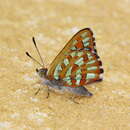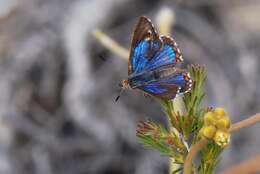Hypochrysops halyaetus This is only the third time I have seen these and they are magnificent. The blue on the male is so brilliant. I didn't see a female with its wings displayed. They have a wingspan of 2.5cm and in the Perth area fly between October to December. "The adult male and female butterflies are different. On top, the males are an iridescent greenish blue. The females are an iridescent purple. Both have chequered black and white margins and an orange border to each hindwing."
lepidoptera.butterflyhouse.com.au/lyca/halyaet.htmlThe eggs are about 1mm and are laid on the host plant. The caterpillars can grow to 1cm and are tended by ants. "Caterpillars of lycaenid butterflies have therefore evolved specialized organs that secrete chemicals to feed and appease ants.[3] Because caterpillars do not automatically pass honeydew, they must be stimulated to secrete droplets and do so in response to ant antennation, which is the drumming or stroking of the caterpillars body by the ants antennae.[2] Some caterpillars possess specialized receptors that allow them to distinguish between ant antennation and contact from predators and parasites, and others produce acoustic signals that agitate ants, making them more active and likely better defenders of the larvae.[18][19] As with homopteran myrmecophiles, ants protect Lycaenid larvae from predatory insects (including other ants) and parasitoid wasps, which lay their eggs in the bodies of many species of Lepidoptera larvae."
en.wikipedia.org/wiki/Myrmecophily#Lycaenid_butterfliesFood plants: Daviesia decurrens, Jacksonia sternbergiana."Breeding: Females lay their eggs at the base of the food-plant close to the ground near the entrance to an ants nest. Larvae feed at night on the foliage and stems and are tended by the ants. "
www.climatewatch.org.au/species/insects/western-jewelWhat an amazing world we live in!!


